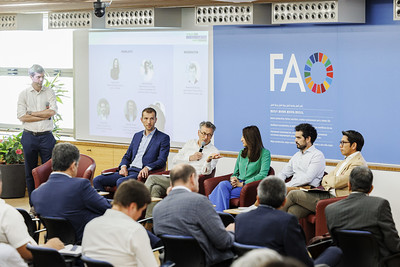How impact investing can narrow the agrifood financing gap

Transforming the world’s agrifood systems to be greener, fairer, more sustainable and regenerative calls for billions of dollars in new investments.
Public funding alone is not enough, especially amid current government belt-tightening.
“The good news is there is growing interest in innovative finance and the realization from all our partners that we need to do much more to mobilize private capital,” said Nuno Santos, the FAO Investment Centre’s new Deputy Director on Business Development.
Innovative financing solutions like impact investing – investments that generate measurable social and environmental outcomes alongside financial returns – can help narrow that financing gap.
The Centre, which is stepping up its work with partners, new and old, around innovative finance, invited a group of impact investors to its Investment Days.
During the annual knowledge sharing event – organized this year around investing in food security and climate resilience – these investors shared how they are overcoming critical barriers to attract and deploy more capital to the agrifood sector.
Greater financial inclusion
One is the Huruma Fund, an agrifood blended fund operating in Latin America, sub-Saharan Africa and Asia, managed by GAWA Capital. The provision of first-loss capital by the European Union has been instrumental for Huruma in attracting nearly EUR 100 million from commercial investors.
As Tomas Ribe, Director of Investments for the Huruma Fund/GAWA Capital, said, “Our bread and butter for the last ten years has been investing in microfinance institutions to support smallholder farmers and microentrepreneurs and in agri-SMEs (small and medium enterprises) directly or through financial service providers.”
A technical assistance facility enables Huruma to address capacity development gaps and improve these institutions’ risk management policies and digitalization.
GAWA Capital is now working to launch a new, larger Huruma fund, which will focus on the “intersection between financial inclusion, agriculture and climate change adaptation and mitigation,” Ribe said, “and support those partners, for example, on regenerative agriculture, agroecology and irrigation systems.”
Tackling climate vulnerability
Countries the least equipped to cope with climate change are usually the ones hardest hit.
Ayesha Khan is Regional Managing Director of Acumen, a non-profit impact investment fund that invests patient capital to help vulnerable countries tackle poverty.
“The solutions exist within these countries, from the small, but vibrant agri-techs, to the high-growth SMEs that can create compelling solutions, which can be scaled up, to larger corporations that require certain incentives,” Khan said. “The goal is to help these entities grow in a way that is suited to their context.”
One example is the climate fund that Acumen is developing to help strengthen climate change adaptation in Pakistan, where catastrophic flooding last year caused loss of lives, widespread displacement and billions of dollars in damage.
The fund, relying almost exclusively on equity investments and accompanied by a sizeable technical assistance component, will invest in the growth stage of small and medium agribusinesses.
Another panelist, Mauricio Benitez, who joined FAO as an Agribusiness and Finance Investment Specialist, shared his years of experience in lending to agri-SMEs in the Global South, most recently with ResponsAbility.
He noted the importance of technical assistance and of managing investors’ expectations.
“Junior and senior investors have different perceptions of risk and return,” he said, “and you have to be transparent and realistic with them.”
De-risking investments
The impact investment group Investisseurs & Partenaires (I&P) finances and supports SMEs and start-ups in sub-Saharan Africa, where three in four agri-SMEs lack sufficient access to finance.
According to Raphaël Dumont, Director of Acceleration and Seed Funding at I&P, agri-SMEs face a funding gap, and the financing solutions out there are often not adapted to the concrete needs of local entrepreneurs.
“There is not enough capital for the demand, and some agri-SMEs are not investment ready,” he said.
To counter the latter, I&P has set up an acceleration programme that provides agri-SMEs with a small interest-free loan and support from a consultant to get them primed to receive proper financing at a later stage from a bank or I&P.
The Missing Middle
The missing middle refers to SMEs too large to be served by microfinance institutions but too small to attract funding from banks.
The social impact investment fund Kampani is targeting the missing middle by providing long-term quasi-equity that finances relatively small capex investments of agri-SMEs or cooperatives to help them grow and strengthen their balance sheets.
The aim is to increase farmers’ incomes and improve their position in agricultural value chains while also contributing to rural development in their communities.
Steven Serneels, Chairman of the Board of Kampani, pointed to the importance of partnering with non-governmental organizations (NGOs) who are mission-aligned.
“The NGOs come in as shareholders and do part of the deal sourcing, among others,” he explained. “Once the deal is bankable, we come in.”
With their in-country presence and close contact with farmers organizations, these NGO partners provide Kampani with “good access to data, good access to management and knowledge of the real situation on the ground,” Serneels said. “From a risk perspective, that’s very helpful.”
For Alexandre Kaufmann, FAO Agribusiness Finance Officer, the panel was inspiring in showing how impact funds with different investment strategies are “developing bold and innovative solutions to attract more capital for the transformation of agrifood systems.”
“The discussion also showed how FAO’s technical expertise and connections with international financial institutions could help impact funds boost capital flows where most needed, in line with FAO’s mission,” he added.
